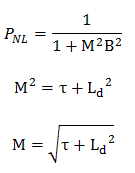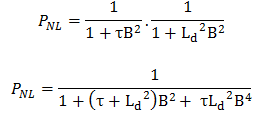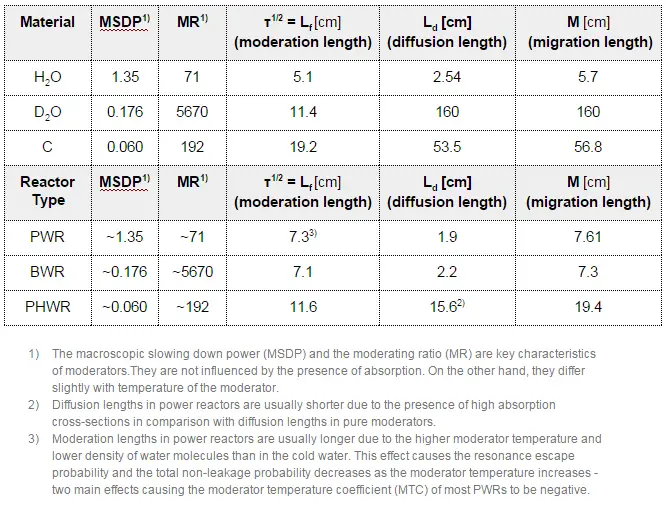Let us define the quantity, M2, where:
M2 = L2 + Ls2 or M2 = L2 + τth
This quantity is called the migration area or square of the migration length. The physical meaning of the migration area is:
M2 is equal to one-sixth of the square of the average distance (in all dimensions) between the neutron’s birth point (as a fast neutron) and its absorption (as a thermal neutron).
In general, the distribution of neutrons within a finite or infinite medium is determined by:
- The source distribution, whether it is an external source of neutrons or is a multiplying environment.
- The geometry (in a finite medium).
- The neutron diffusion length, L2 = D/Σa L2, is the diffusion area. It is proportional to the distance thermal neutrons travel before they are absorbed.
- The slowing-down length, Ls, of a neutron. It is proportional to the distance fast neutrons travel from when they are born to the point where they become thermalized. Since it can be derived from Fermi age theory, a parameter τ, called the “age” (often called the “Fermi age”), is often used.
Let us focus on the diffusion length and the slowing-down length.
The physical meaning of the diffusion length is that:
L2 is equal to one-sixth of the square of the average distance (in all dimensions) between the neutron’s birth point (as a thermal neutron) and its absorption.
The Fermi age is related to the distance traveled during moderation, just as the diffusion length is for thermal neutrons. The Fermi age is the same quantity as the slowing-down length squared, Ls2, but the slowing-down length is the square root of the Fermi age, τth = Ls2. The physical meaning of the slowing-down length is:
Ls2 is equal to one-sixth of the square of the average distance (in all dimensions) between the neutron’s birth point (as a fast neutron) and the point where it has become thermalized.
Let us define the quantity, M2, where:
M2 = L2 + Ls2 or M2 = L2 + τth
This quantity is called the migration area or square of the migration length. The physical meaning of the migration area is:
M2 is equal to one-sixth of the square of the average distance (in all dimensions) between the neutron’s birth point (as a fast neutron) and its absorption (as a thermal neutron).
The distance traveled by fast neutrons during moderation and the distance traveled by thermal neutrons during diffusion in a reactor is important to reactor design because of their effect on the critical size and their effect on the neutron leakage.
Effect on the Neutron Leakage
 It can be derived the total non-leakage probability of large reactors is primarily a function of migration area.
It can be derived the total non-leakage probability of large reactors is primarily a function of migration area.
Fast Non-leakage Probability
It can be derived from the Fermi age theory, the probability that a neutron will remain in the core and become a thermal neutron without being lost by fast leakage is also represented by the following equation:
where τ is the Fermi age of the neutron, B is the geometrical buckling (in case of critical state Bg = Bm), which depends only on the shape and size of the core. The value of B for small cores is higher than the value for large cores. So that, it is obvious, the fast neutrons leakage is higher for small cores and depends on the macroscopic slowing down the power of neutron moderator (leakage is higher for poor moderators).
Thermal Non-leakage Probability
It can be derived from the neutron diffusion theory. The probability that a thermal neutron will remain in the core is also represented by the following equation:
Ld is the diffusion length, B is the geometrical buckling (in case of critical state Bg = Bm), which depends only on the shape and size of the core. The value of B for small cores is higher than the value for large cores.
Total Non-leakage Probability
The fast non-leakage probability (Pf) and the thermal non-leakage probability (Pt) may be combined into one term that gives the fraction of all neutrons that do not leak out of the reactor core. This term is called the total non-leakage probability and is given the symbol PNL, and may be expressed by the following equation:
We can rewrite this equation without a substantial loss of accuracy for large reactors simply by replacing the diffusion length Ld and the fermi age τ with the migration length M in the one group equation. The term B4 is very small for large reactors, and therefore it can be neglected. We may then write.
where M is the migration area (m2), the migration length is defined as the square root of the migration area. As can be seen, the total non-leakage probability of large reactors is primarily a function of the migration area.



